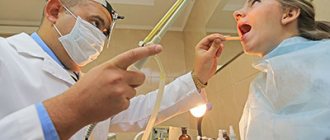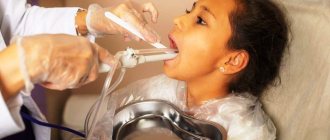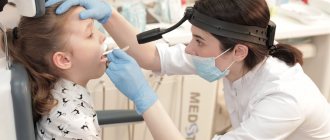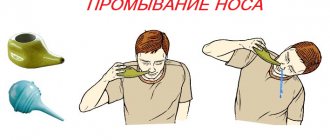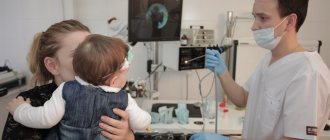Why do you need to rinse your tonsils?
The palatine tonsils are an organ of the human immune system. They are located at the very entrance to the pharynx on both sides. Outwardly, they resemble almonds. This similarity gave this organ its name. The tonsils consist of a large number of winding canals - crypts. On the surface of the tonsils there are small depressions - lacunae. It is in them that tonsillitis plugs accumulate, which are removed by washing.
Our tonsils act like a filter. They filter everything that enters the oral cavity from outside. And if infectious flora gets on the surface of the tonsils, they begin to produce lymphocytes - cells of the immune system that begin to fight the “enemy”.
If the body's defenses are not enough to cope with viruses and bacteria, an inflammatory process (chronic tonsillitis) starts in the palatine tonsils. In the gaps, pathogenic microflora is activated, the remains of bacterial activity and dead leukocytes accumulate. This entire “mixture” is compressed and turns into white-yellow plugs on the tonsils, which are noticeable upon examination and emit an unpleasant odor. These plugs do not allow inflammation to subside, so sanitation of the tonsils is an important part of the treatment of chronic tonsillitis.
Often, rinsing is the only way to preserve the tonsils and avoid their removal.
Types of purulent sore throat
In otorhinolaryngology, several forms of the disease are distinguished: catarrhal, follicular, lacunar, and phlegmous, ulcerative-necrotic, dental and latent (Simanovsky-Plaut-Vincent). Immediately after diagnosis, qualified treatment of the disease should be started on the same day in adults and children, regardless of the form of the disease. In this article we will describe the most basic forms of sore throat.
With follicular tonsillitis, the tonsils become greatly enlarged, and purulent spots appear on their surface. The disease begins rapidly with a sharp rise in temperature to 40°C. The lymph nodes become enlarged, and when pressed on them the patient experiences discomfort. The patient is overcome by headaches, “aches” throughout the body and general malaise.
With lacunar angina, purulent masses penetrate into the thickness of the entire tonsil, filling its lacunae. To the symptoms of follicular tonsillitis, a reaction from the gastrointestinal tract is added: vomiting, diarrhea, nausea. A characteristic yellowish coating is noticeable on the tonsils, upon removal of which the patient feels improvement and the body temperature drops.
Phlegmonous is the most severe form of the disease. It is characterized by the accumulation of purulent masses in the tonsil, the patient’s temperature reaches 40°C. In parallel, swelling of the neck and perimaxillary area occurs. Possible respiratory arrest. The patient experiences severe pain: it becomes impossible to speak or swallow. The patient must be immediately sent to hospital, since in the absence of prompt assistance there is a risk of death.
Such a division, of course, is quite arbitrary, since one type of disease can transform into another and cause serious health problems (provided that qualified treatment of the disease is not provided to adults).
Contraindications to the procedure
Properly performed sanitation of the tonsils is a highly effective procedure for chronic tonsillitis. But in some cases, the patient may be refused to undergo lavage. Contraindications to manipulation are:
- an infectious disease in the acute stage (here we are talking not only about inflammation of the tonsils, but about any inflammatory processes in the oropharynx. Even carious teeth can cause refusal to carry out the procedure, since during manipulation the infection can get to healthy tissues);
- oncological diseases;
- retinal diseases;
- first and last trimesters of pregnancy;
- diseases of the cardiovascular system;
- high blood pressure;
- children under three years old;
- individual intolerance to the solutions used for washing.
In other cases, washing the palatine tonsils, carried out by a competent ENT doctor, gives an excellent result and allows you to achieve long-term remission when the symptoms of the disease do not bother you. The procedure is safe and well tolerated by patients. And most importantly, a high-quality procedure allows you to save the tonsils and avoid surgery to remove them.
There are several methods for carrying out the procedure: sanitation using a syringe and the vacuum method of washing the tonsils.
What is this procedure?
Tonsilor is a special device that came into the arsenal of otorhinolaryngologists several years ago, but has already proven its undeniable effectiveness. The method is based on the vacuum effect on the pathological contents of the lacunae of the tonsils. Tonsilor rinsing can be carried out even in an outpatient clinic; it is enough that the doctor has the necessary equipment and sufficient experience.
To be completely confident in safety and guaranteed results, make an appointment at a diagnostic and treatment center in Moscow. Our specialists will cope with the task quickly and efficiently!
Our clinic constantly hosts promotions
Syringe method
This is the most common and accessible method of performing the procedure. And most likely, when you go to the district clinic, you will be offered exactly this.
To carry out the procedure, a needle-free syringe with a curved cannula attached to it is used. An antiseptic solution, for example, a furatsilin solution, is drawn into the syringe. The syringe directs a stream of solution directly into the lacuna. The jet “breaks” the tonsillitis plug. Purulent masses, washed out of the lacunae by the solution, enter the mouth. At this moment, the patient must spit the washing solution into a special tray along with the washed purulent contents. As soon as the manipulation is completed, the surface of the tonsils is lubricated with Lugol's solution.
This method is referred to as the old, “grandfather” methods. Yes, this method is inexpensive, but it cannot be called very effective either. With this technique it is impossible to completely rinse the tonsils and remove deeply located caseous masses. Also, such sanitation requires good professional training from the otolaryngologist. An inexperienced ENT doctor can injure the surface of the tonsils with a syringe, which will lead to the spread of infection to healthy tissue, which will only worsen the situation.
The apparent simplicity of performing such a flush convinces patients to buy a syringe at a pharmacy and try to carry out the procedure at home. But only a few manage to cope. Firstly, we should not forget about the traumatic nature of the method, and secondly, it is not possible to maintain the proper level of sterility at home.
Sanitation with a syringe is an inexpensive and accessible method. But it is much more effective to carry out vacuum rinsing using the Tonzillor apparatus.
Types of washing
Purpose of appointment: to remove pus from the lacunae and treat them with a drug. After this, the patient's condition improves significantly.
Specialists carry out the procedure in different ways:
syringe. A solution is drawn into a 20-gram syringe. Instead of a needle, a special nozzle with a curved end is put on so that the solution falls directly on the stopper. The liquid under the pressure of the piston is fed into the lacuna and flushes it.
Washing the tonsils- Vacuum method of washing tonsils . The tonsils are anesthetized, a vacuum suction cup is attached to them, through which the purulent contents are pumped out. After this, the medicinal composition is pumped into the lacuna.
- Ultrasonic washing of tonsils . The cleaning principle is based on a combination of cavitation and ultrasound. Air bubbles form in the washing liquid, and when they rupture, the membranes of microbial cells are damaged.
The Kuntsevo Medical Center has modern otolaryngological equipment, which allows the operation to be performed as quickly, efficiently and painlessly as possible.
Vacuum method
To carry out the manipulation, an ultrasonic device “Tonsillor” is used. As standard, the device comes with a vacuum nozzle for washing gland lacunae. At the beginning of the manipulation, the ENT doctor performs topical anesthesia of the palatine tonsils with a solution of Lidocaine. The patient sits comfortably in a chair and opens his mouth.
The vacuum nozzle is brought to the surface of the tonsils and attached to it. The washing solution is fed through a nozzle, passes through the gaps and, under pressure, washes out all the pathogenic contents from them. Antiseptic or saline solutions are used as flushing solutions. The solution passes through the thickness of the tonsil once and is not reused, since after washing it is removed into a special suction.
Since the waste solution goes directly into the suction, infection of healthy tissues during the manipulation is excluded.
The procedure is carried out under the influence of ultrasonic vibrations, which allows the medicine to penetrate deeper layers of tissue, and this contributes to a rapid recovery.
In general, the procedure on the Tonsillor apparatus resembles the principle of operation of a vacuum cleaner. This vacuum sanitation allows you to effectively clean the lacunae of the tonsils and get rid of purulent accumulations.
On average, five to ten sessions are required to achieve a lasting therapeutic effect.
At this point we could put a full stop and end the article. But there is another way to carry out vacuum rinsing - using a modified attachment of the Tonsillor device, which is used only in the ENT Clinic of Doctor Zaitsev.
How to get to the procedure
To sign up for lavage of lacunae, you first need to undergo a high-quality examination, which can only be carried out by an experienced ENT specialist:
- visual inspection of the tonsils;
— collection of information about the course of the disease;
- tests;
Only after taking these necessary measures does the doctor decide whether the patient needs this medical procedure, since it has contraindications.
Where to get tonsil treatment
The Elena Malysheva Medical Center offers washing of the lacunae of the palatine tonsils, the cost of the service will not hit your pocket.
Doctors with high qualifications and extensive experience will conduct all the necessary studies before and after the procedures. They will determine whether the patient has contraindications and prescribe the required number of rinses to achieve the maximum therapeutic effect.
All manipulations with the tonsils occur only with the help of the most modern equipment that meets all international quality standards.
If you choose the Elena Malysheva Medical Center, then you are turning to real professionals.
Diagnostics
THE INSTITUTE OF ALLERGOLOGY AND CLINICAL IMMUNOLOGY has a fundamental base that allows it to carry out the full range of diagnostic and therapeutic measures for any form of allergy that meets the level of international standards. Many of the diagnostic and treatment methods were developed by the staff of our Institute.
Diagnostic measures are based on anamnesis, clinical picture and laboratory diagnostics.
- Bacteriological examination of mucus from the tonsils and posterior pharyngeal wall for aerobic and facultative anaerobic microorganisms.
- Determination of the sensitivity of microorganisms to antibiotics and other drugs.
- Detailed general (clinical) blood test, clinical urine test.
- Determination of the concentration of C-reactive protein in blood serum.
- Determination of antistreptolysin-O in blood serum.
What effect does this procedure give?
When completing a full course, which consists of 5-10 procedures, washing the lacunae of the tonsils with the device helps:
- complete cleansing of the oral cavity from pathogenic bacteria and their metabolic products;
- creating the necessary conditions for the penetration of drugs into the affected area;
- improving blood supply and cellular nutrition of tonsil tissue;
- reducing the inflammatory process;
- improving local immunity.
Symptoms
Rheumatism of the joints, inflammation of the myocardium, endocardium can be a consequence of chronic tonsillitis! Strictly follow the instructions of the otorhinolaryngologist!
- Frequent sore throats.
- Local symptoms: sore throat, discomfort, sore throat, etc.
- Bad breath.
- Reflex coughing attacks caused by irritation of the mucous membrane of the palate and larynx.
- Enlarged cervical lymph nodes (this symptom is typical for children and adolescents, but can occur in adults).
- Low-grade fever.
- Headache, weakness, weakness.
- Changes in the heart.
What needs to be done first?
Before starting treatment procedures, it is recommended to visit an otolaryngologist. You may also need to undergo the following examinations:
- general blood analysis,
- bacteriological examination of the tonsil area,
- rheumatic tests.
To avoid possible discomfort caused by the gag reflex, it is strongly recommended to carry out the procedure on an empty stomach. That is, the last meal and water should be taken at least 3 hours before visiting the clinic. And after washing the tonsils, you must not eat or drink for another 40-60 minutes for the treatment to proceed properly.
More accurate information can always be obtained by making an appointment by phone.
Causes
The etiology and pathogenesis of chronic tonsillitis has not been fully studied to date.
The starting mechanism in the development of chronic tonsillitis is repeated inflammatory processes leading to local immunosuppression.
- Local causes are infectious foci (carious teeth, purulent sinusitis, etc.).
- Pathogenic and opportunistic microorganisms.
- Immunodeficiency states.
- Persistent violation of nasal breathing (adenoids in children, deviated nasal septum, etc.).
- Allergic sensitization of the body.
How is ENT rinsing of tonsil lacunae done with the “Tonsillor” apparatus?
This procedure involves simultaneous exposure of the affected area to vacuum and ultrasound. The first exerts accentuated mechanical pressure on the tonsils, helping to effectively remove purulent plugs. Ultrasound has an anti-inflammatory and bactericidal effect. In addition, it improves blood supply to the ENT organs and helps to increase the effectiveness of drug therapy, which together accelerates the tissue healing process and the patient’s recovery.
